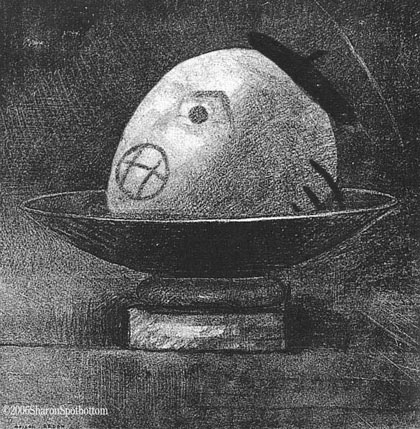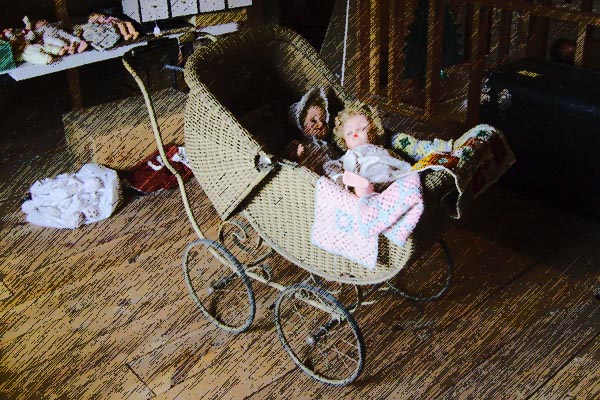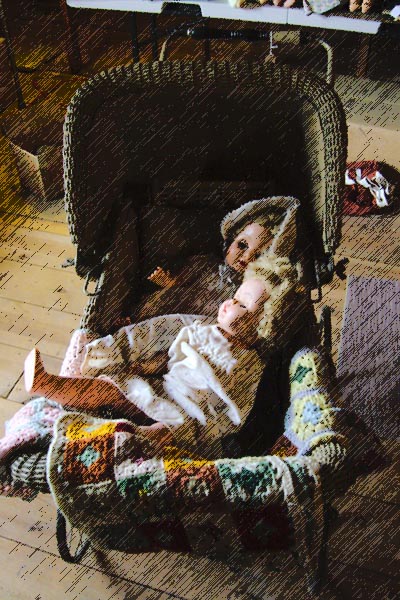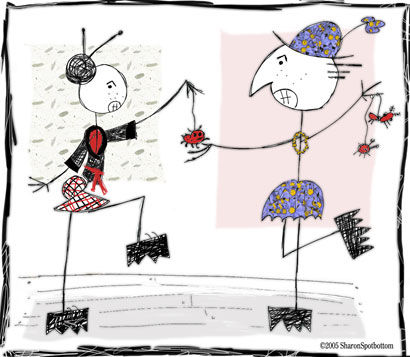 In 2009 a group of four young Icelandic women began performing what they called “Friendly Concerts” in Reykjavík under the name Pascal Pinon. In October they appeared at the Iceland Airwaves Festival where I was most impressed by their performance. Although I didn’t know it at the time, they had already recorded an entire concept album which they later released independently; it was picked up by Morr Music in Berlin and re-released worldwide. Last October my blog-pal DJ Cousin Mary (from radio station KFJC in Los Altos Hills, California) went to the 2010 Iceland Airwaves where she saw them perform. Recently Mary did a three-hour special on Icelandic music and during the show interviewed Jófríður Ákadóttir, the primary songwriter for the group. A transcript of that interview follows:
In 2009 a group of four young Icelandic women began performing what they called “Friendly Concerts” in Reykjavík under the name Pascal Pinon. In October they appeared at the Iceland Airwaves Festival where I was most impressed by their performance. Although I didn’t know it at the time, they had already recorded an entire concept album which they later released independently; it was picked up by Morr Music in Berlin and re-released worldwide. Last October my blog-pal DJ Cousin Mary (from radio station KFJC in Los Altos Hills, California) went to the 2010 Iceland Airwaves where she saw them perform. Recently Mary did a three-hour special on Icelandic music and during the show interviewed Jófríður Ákadóttir, the primary songwriter for the group. A transcript of that interview follows:
MARY MACDONALD: I’m talking to Jófríður from
Pascal Pinon… Now tell us about your band, it’s you and your sister right?
JÓFRÍÐUR ÁKADÓTTIR: Yes, it’s called
Pascal Pinon and we mostly just play indie-acoustic pop music. It’s always written in my bedroom so I think you can sort of hear it, because it has a lot of shyness in it because we’re both very shy… when I’m writing I always do it in my bedroom and I always play very low so I hope that nobody can hear…
MARY:
(laughs)
JÓFRÍÐUR: … I think that maybe I can hear that in the music because it always colors it, how it comes into the world, I think, and that’s sort of where my music is born.
MARY: Is there anyone other than your sister and you in the band?
JÓFRÍÐUR: We always play four girls when we play concerts, but we just get session players for the shows because we used to be four in the band, two other girls with us, but then after a year of working together they decided to quit because it was getting a bit hard, and me and Ásthildur were doing everything, mostly, so we all just agreed, they just stopped being in the band… sometimes playing with us, sometimes doing other things… it actually works out a lot better this way.
MARY: You began playing when you were very young, isn’t that true? How old were you when you started?
JÓFRÍÐUR: Well, this band we started when we were fourteen, and today we are sixteen, almost seventeen.
MARY: Oh, I see, so you’re still in school…
JÓFRÍÐUR: Yes, and it’s actually Easter break now and we're using the Easter break to make the second album.
MARY: Oh, how exciting…
JÓFRÍÐUR: It’s very exciting!
MARY: You and your sister are twins, isn’t that true?
JÓFRÍÐUR: Yes, we’re twins.
MARY: You say you’re shy, yet you get up and perform… Do you enjoy performing?
JÓFRÍÐUR: Yeah, I think it‘s really, really fun to perform. The first concert—it was terrifying! My feet were shaking and we couldn’t stand because I was so nervous and we had to sit down and my feet were both shaking really, really fast. It was awful because I was so nervous and afraid and shy—and that was the first concert. And then you just sort of learn that people aren’t really that mean, they always kind of seemed to be really positive, and after playing many, many concerts, and people seem to be very happy, it’s not that frightening anymore, it really gets kind of fun and you start to enjoy it a lot because its really really fun to play your own songs in front of an audience.
MARY: There's a sweetness and a warmth to your music, at least that’s why I enjoy your music, so I would think that would appeal to a lot of people.
JÓFRÍÐUR: I think our music, because its been called very cute, and I think that it is very cute, and it’s very warm and it’s very happy, in a way. It’s kind of if you would imagine something very soft. I have nothing against being soft, but I also think that it cannot be too soft, and it cannot be too cute and it cannot be too much of anything. I think it’s very important that all of the things that you write, all this cuteness, and the shyness, that it doesn’t get too much of anything.
MARY: Now, have you written new songs for your new CD that you’re mixing?
JÓFRÍÐUR: Yes we have fifteen songs that we’re going to choose from, and we have recorded fourteen.
MARY: The songs that you’ve composed, have they changed over time, from the first songs?
JÓFRÍÐUR: Well, um, we’re experimenting a bit, on the second album, with shakers and a bit of drums, because if you heard the whole album you notice that there are no drums, or shaker, or anything at all, on the whole entire album, we’re experimenting a bit with that. I think that maybe the compositions, in general, haven’t changed that much. I mostly noticed that the sound is improving and we’re exploring a bit of kind of different sound world on the second album. There’s one song that is very different from all the other songs. I think the most, the biggest difference with this album and the other is that the first album is a really, really whole unit. It’s a really whole album—it has a very similar sound to all the songs and it kind of forms a very special wholeness—if that makes sense (
laughs) because it was recorded in five days and we had been practicing these songs for a long time and we knew exactly what we were going to record and we just did it. This album is recorded in three different places. It was recorded first of all in the summer, the summer of 2010, when we had a recording session, and again, when we had the next break from school—it was the Christmas break—and then we did some recordings now, in the Easter break. So we’re using all our breaks to record. And the songs we’ve been adding, more and more songs to the album with time. There’s not much similarity in all the songs as it was in the first album, so the sound is kind of different from each song. But in a way, I think that’s also interesting, to make an album that has a very mixed diversity, or at least more diversity than the first album.
MARY: What kind of musical education do you and your sister have?
JÓFRÍÐUR: We have both studied classical music, and we are studying now. Ásthildur is a really good piano player, a classical piano player, and I play the clarinet, I have been playing the clarinet since I was eight years old and we are very much busy at the music school all the time, except for the breaks, then when we have time to be in a band. I also play piano too, but very little. Ásthildur plays the bassoon.
MARY: Are you attending a music school right now?
JÓFRÍÐUR: Yes we are, we are in the Music School of Reykjavík.
MARY: Is that at the high school level?
JÓFRÍÐUR: Yeah.
MARY: When will you be going to university?
JÓFRÍÐUR: In three years from now, it's a different system…
MARY: Well, that’s a long time.
JÓFRÍÐUR: We’re also very young… so it kind of adds up.
MARY: You’ll have plenty of time to do what you're doing right now.
JÓFRÍÐUR: Um-hmm. I think we just don’t really realize how young we are. We have all this time to do so many things. Sometimes we kind of get lost in always comparing ourselves to some people who are older and have been doing this thing for a lot longer time. I thinks that’s one sort of mistake that you make and you have to be very careful sometimes because we are very young and we have to sometimes be careful not to compare ourselves too much.
MARY: Well, not to compare you to other people, but to compare Iceland to other countries, it seems to me that there are a lot of musicians in Iceland, given the small population, do you agree?
JÓFRÍÐUR: I agree, and I think that there are strangely many good musicians here. I really like this whole indie community that had been formed here, and this whole music scene. I really like it and there are a lot of people in it, and it’s really lucky to be a part of it.
MARY: I agree. Do think there's anything particular about Iceland that has made this happen?
JÓFRÍÐUR: No, I really cannot tell because it’s so hard to spot something that you’re a part of. It’s really hard to look at it as an outsider. I don’t really know why it has become the way it is. I really always think it is a huge misunderstanding that it has anything to do with nature. I think that’s just something that Björk created. Sometimes, when we do interviews, and there are people from other countries, they ask: “Has the nature affected your music in any way?” and we always say “No!” (
laughs) because I cannot see how nature can possibly be connected with music, at least not the type of music that we make. But I understand maybe Björk always talks about how she's hiking in the mountains and looking at the wilderness… I think maybe this somehow works for her, but I don’t think it has anything to do with the rest of the Icelandic music scene. I haven’t really thought about this very much. I like the way it is and I haven’t been wondering why everything is the way it is. I’m kind of just thankful for it.
MARY: Are there other Icelandic Musicians that you particularly like, or that you feel influenced you?
JÓFRÍÐUR: Yes. I really like Sóley, who is also with Morr Music, and I also really like Sin Fang, who is also with Morr Music and Sóley is playing with him, and I also like Nolo a lot. They’re not very famous, but they are really, really good.
MARY: OK, I’ll have to look for them.
JÓFRÍÐUR: Yes. I would look for Nolo on gogoyoko- have you been visiting
gogoyoko.com?
MARY: No, that sounds like a good idea.
JÓFRÍÐUR: Yeah, that’s a really good site… it’s a music webshop…
MARY: What about other musicians that have influenced you, in the whole world? Is there anyone in particular?
JÓFRÍÐUR: Yes, we were quite obviously interested in Tegan and Sara when we were beginning the band, when I was 14 the only thing I could listen to was Tegan and Sara and I think that without realizing it I was becoming very influenced by their music in my own compositions, maybe
I Wrote a Song, which was one of the first songs we played together. Tegan and Sara, they’re Canadian twins—but they’re identical twins. Maybe it’s different.
MARY: Could be. Did you study composition or did you just start writing songs?
JÓFRÍÐUR: No, I’ve been doing this for a long time, it started when I first got my guitar… it was a Christmas present from my parents when I was eleven. I got an electric guitar and I got a book to learn how to play the guitar. I learned the chords and one of the first things I did was to write very, very awful songs on it and they were all very, very bad. Then later I started writing better songs (
laughs). Then we got the idea of maybe starting a band and I was the only who could stand up and say “I have written a song—maybe we can play it?”
MARY: Is there anything else you’d like to tell our listeners about your music or Iceland?
JÓFRÍÐUR: I think its really really fun to be in concert in Iceland, I think it’s really a special atmosphere in concerts in Iceland. I think because everybody seems to know each other… all the musicians are watching the other musicians, this whole scene is really connected. It’s sort of like it is a family.
MARY: I could sense that, even being an outsider. I could definitely sense that. Thank you so much for talking with me and with my listeners, and I wish you all the best of luck.
JÓFRÍÐUR: Thank you.
And thanks again to DJ Cousin Mary and radio station KFJC for supporting Icelandic music and airing this interview.
Photo: Lilja Birgisdóttir
Interview Copyright KFJC, 2011. USED BY PERMISSION





























